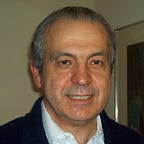The Magic Coronene
I named the following magic figure “The Magic Coronene”, as it has the same shape as the molecular structure of the Coronene crystal, with the formula C24H12.
Our magic figure has 7 hexagonal cells. Each cell can be filled with one of the consecutive numbers from 1 to 7.
This is the smallest “magic” figure that we know of, since the smallest widely known is the 3 x 3 magic square, which has 9 cells. The magic square displays 8 ways, along horizontal, vertical and diagonal lines, in which its numbers add to the same total: its magic number 14.
How will the Magic Coronene compare?
With the Magic Coronene, we can consider three directions, as shown in the figure below by the colored arrows, and we expect our sums to be symmetrical with respect to the center (linear symmetries).
We are looking for two linear symmetries, along each direction.
Since the total sum of all the numbers in the figure (1+2, … +7) is 28, if we find two sums in one direction that add up to the same magic number, our magic number will be 14, which is half of 28.
We can quickly find that the number 7 must be in the center cell, and that remaining six numbers, taken two at the time, can add up to 7. Thus, the following solution, which is one of the possible permutations, is the only solution that verifies linear symmetries in the three directions (and more):
For example, in the horizontal direction, we obtain a sum of 14 by adding the three numbers in the central row, 1, 7 and 6. We also obtain 14 by adding the four remaining cells, two on the top row, and two on the bottom row. These two ways to achieve our magic sum are indicated by the green arrows.
The same is true in the other two directions. Thus, so far, the solution shown displays 6 ways in which its 7 numbers add up to its magic number (14).
However, the magic Coronene displays further properties: We can find two point symmetries with respect to its center.
In the figure below, we can see how the three green cells add up to 14, and the remaining white cells also add up to 14.
Looking at our solution, we notice more symmetries:
- We have already stated that the numbers on opposite cells with respect to the center must always add up to 7.
- Each number in the green cells is the sum of the two numbers on its sides. That is, 3 is 1+2; 5 is 1+4; and 6 is 2+4.
- What about the white peripheral cells in between the green cells? Starting from the cell containing number 1 and going clockwise, we notice that 1 is 3 minus 2 (the next two cells). Similarly, 2 is 6 minus 4, and 4 is 5 minus 1.
Thus, we discovered that this Magic Coronene solution displays 6 linear symmetries along the three directions, 2 point symmetries with respect to the center, and more.
The Magic Coronene, with only 7 numbers, displays more properties than the classic magic square with 9 numbers! To summarize:
Linear symmetries:
- horizontal (green arrows): 1+7+6 = 14; and 3+2+5+4 = 14
- slanted (blue arrows): 3+7+4 = 14; and 1+5+2+6 = 14;
- slanted (gray arrows): 5+7+2 = 14; 1+3+4+6 = 14;
Center point symmetries:
- sum of green cells: 3+6+5 = 14
- sum of white cells: 1+2+4+7 = 14
Other properties:
- green cells: The number is the sum of the two numbers in the two adjacent cells.
- White peripheral cells: The number is the subtraction of the two numbers found contiguously in the clockwise direction.
Its bigger sister
The next order hexagonal magic figure is composed by 19 contiguous hexagons and has only one solution. Its magic number is 38:
If you enjoyed reading this article you may also enjoy: The Magic Cross and Other Magic Figures at https://medium.com/@gori70/the-magic-cross-and-other-magic-figures-3c79c88b67ff
